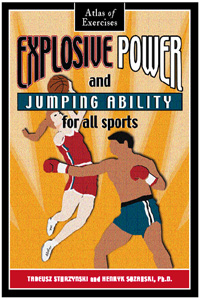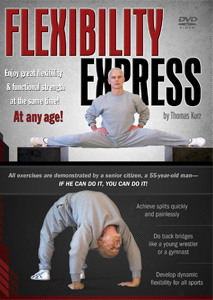by Thomas Kurz
Resistance Machines
Most resistance machines offer either isolated movements (knee extension, knee curl) or alter the natural path of movement in complex movements (Smith machine).
The Smith machine forces you to move the bar on a straight line while your body is planted in one spot. This is not a natural movement pattern. In a natural squat the bar moves in an arc, the more pronounced when you squat on the whole surface of the soles of your feet. The straight up and down movement of the bar while your feet are planted in a Smith machine squat produces excessive strain on the lower back and knees (Bompa and Cornacchia 2012).
The isolated movements, such as leg extensions or leg curls, produce greater shearing forces within the moving joint than the complex movements such as squats, so leg extensions with less than 50° of knee flexion (meaning at any angle greater than 50°), for example can strain the anterior cruciate ligament of the knee. To produce similar shearing forces in a natural squat, you would need to flex your knees below 50°, practically sitting on your heels (Barrentine 1996).
Both squats and leg presses produce greater activity of the hamstring and gastrocnemius (calf muscle) throughout the majority of the movement than do knee extensions. Natural squats generate 20-50% more quadriceps activity, 65-140% more hamstring activity, and 15-35% more gastrocnemius activity than leg presses (Barrentine 1996).
The best means to increase bone density are weight-bearing exercises that involve many muscle groups and direct the force vectors through the spine, hips, and shoulder girdle, such as squats, deadlifts, cleans, shoulder presses, and bench presses (Baechle and Earle 2008).
Research by Chilibeck et al. (1996) showed that women who did 20 weeks of resistance training on a Universal-type machines increased their muscular strength but not their bone mineral density.
Women who did 27 weeks of gymnastic training increased their lean tissue mass more than the women in the previously quoted study (6.7% versus 3.7%) and significantly increased their bone mineral mass (Nichols et al. 1994). Similar results were achieved with six months of high-impact exercises (Bassey and Ramsdale 1994). The natural whole body loading in the gymnastics and high-impact exercises improved lean tissue and bone density more than the Universal-type machine.
To build useful strength of muscles and bones, do exercises that closely resemble the natural forms of human movements, such as squats, lunges, deadlifts, push-ups, bench presses, chin-ups, sit-ups, abdomen crunches, varieties of pull and jerk and snatch done with both arms and with one arm. In all those exercises your muscles work the way they do in your sport and in life.
Abdominal Training Devices
Beim et al. (1997) compared the activation of abdominal muscles in various abdominal training gizmos, a bent-knee sit-up, and in a standard abdominal crunch. The abdominal crunch activated both the upper and the lower abdominal muscles more than the sit-up. Only one gizmo activated the upper part of the rectus abdominis more than the standard crunch—because this gizmo offered additional resistance during the movement while the crunch was performed without additional resistance. For fair comparison with that gizmo the abdominal crunch would have to be performed while holding a weight plate. It looks to me that an abdominal crunch with additional weight is as good as the best “abdominal training device.”
Stretching Machines
In my 25 years of living in Poland I have not seen even one stretching machine and I worked out in the best equipped training halls in Warsaw (at AWF—the University School of Physical Education), and in several other cities. I didn’t see a stretching machine anywhere because athletes do not need stretching machines. In relaxed stretches for the hips and thighs, you can as easily relax into a stretch on your own on a smooth floor. In isometric stretches for hips and thighs, a machine will make it more difficult for you to tense your muscles because it prevents the weight of your body from pressing on your thighs and thus forcing them to tense more. The harder you tense in isometric stretches, the greater is the following relaxation and the resulting stretch.
If you want to stretch the muscles of your shoulders and arms, then a rope with knots held behind your back and worked with your hands like a rosary or prayer beads is all you need.
Stretching machines “may be particularly helpful for special populations, such as the elderly and those with physical problems that prevent them from executing certain stretches by themselves” (“Stretching Machines,” 1999). Unless you have been severely injured or have a crippling disease, you do not need a machine to increase your flexibility. Manufacturers of stretching machines know it too. The editors of Georgia Tech Sports Medicine & Performance Newsletter report a study of stretching machines conducted at the University of Oregon and funded by a company that manufactures stretching machines. The study showed flexibility gains among people who stretched on the machines but their gains were not compared to the people who stretched without machines (“Stretching Machines,” 1999).
References
Baechle, T. and R. W. Earle, ed. 2008. Essentials of Strength Training and Conditioning. Champaign, IL: Human Kinetics.
Barrentine, S. W. 1996. The Biomechanics of Knee Exercises. Research Quarterly for Exercise and Sports, March 1996, Vol. 67 Supplement, p. A-19.
Bassey, E.J. and S. J. Ramsdale. 1994.“Increase in femoral bone density in young women following high-impact exercise.” Osteoporosis International vol. 4, no.2, pp. 72-5.
Beim, G. M., J. L. Giraldo, D. M. Pincivero, M. J. Borror and F. H. Fu. 1997. “Abdominal strengthening exercises: a comparative EMG study.” Journal of Sports Rehabilitation vol. 6, no. 1, pp. 11-20.
Bompa, T. O., M. Di Pasquale and L. J. Cornacchia. 2012. Serious Strength Training. Champaign, IL: Human Kinetics.
Chilibeck, P. D., A. Calder, D. G. Sale and C. E. Webber. 1996. “Twenty weeks of weight training increases lean tissue mass but not active bone mineral mass or lean density in healthy, active young women.” Canadian Journal of Physiology and Pharmacology vol. 74, no. 10, pp. 1180-1185.
Nichols, D. L., C. F. Sanborn, S. L. Bonnick, V. Ben-Ezra, B. Gench and N. M. DiMarco. 1994. “The effects of gymnastics training on bone mineral density.” Medicine and Science in Sports and Exercise vol. 26, no. 10, pp. 1220-5
“Stretching Machines.” Georgia Tech Sports Medicine & Performance Newsletter vol. 7 no. 12 August 1999, p. 6.
If you have any questions on training you can post them at Stadion’s Sports and Martial Arts Training Discussion Forum



